“You’ve got a lot of nerve,” a native Spaniard might tell me, “to book a tourist trip to inland Andalucia in August.”
True. I’ve lived in Spain three years, know better. Andalucia cities regularly rack up summer scorchers north of 40° Celsius. (104° Fahrenheit. Ow! Ow!) I’ve listened wide-eyed as natives swapped anecdotes on surviving childhood dog days in Granada and Córdoba. A Rick Steves’ contributor may even have presciently anticipated this post in 2016 with an apt forum question: ‘Andalucia in August – are we nuts?’
But: I seem to have been infected with the Spain August travel bug, and my camera has long whined and nagged for an expedition to Ronda, home of the spectacular-and-then-some Puente Nuevo and El Tajo (gorge). I lurked on weather web sites, spotted a forecast of a mere … umm … 35° for Ronda, and was foolish enough to think I could waltz about cozily in such a clime with a jumbo dSLR and extra lens slung around my neck. No fool like an old fool! Off I went.
This post will offer lots of pics, like my recent missive about the Bernina Express. If you want to see one or several in higher res, please visit the directory listing and click on the appropriate file. Old school web authoring.
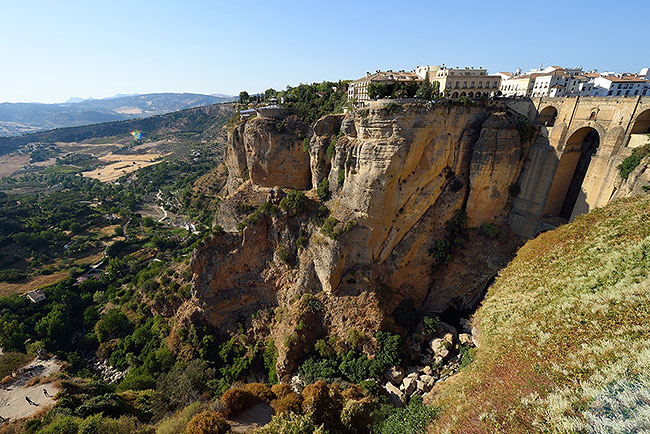
Various tribes have called dibs on Ronda since the sixth century B.C.: the Celts, who called it Arunda, the Phoenicians, and the Romans, who thought Ronda would make for a keen-o fortress during the Second Punic War. The Visigoths nabbed it, ruled until 713, when the Moors conquered Ronda and renamed it Hisn Ar-Rundah. The Marquis of Cádiz took over in 1485, shortly before the Spanish Inquisition.
I smugly presume, but can’t prove, that these Andalucians of yesteryear prized Ronda as a military outpost. Have a look at those cliffs. It would be tough for nefarious evildoers to mount a surprise attack, wouldn’t it?, if you’ve claimed the tippy-top and they’re stuck in the brush far below. Maybe for an Alain Robert type.
Please note the eenie-weenie humans in the lower left corner. A TripAdvisor reviewer tells how you might join them. I did, later, but took the shot above from the viewing terrace at Casa don Bosco. A couple of euros admission, well invested.
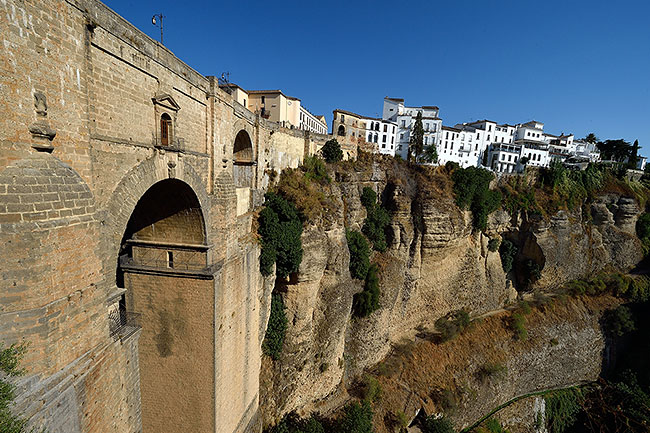
Puente Nuevo means “New Bridge” in Spanish. You’re looking at it, on the left side of this shot. Only in Spain could a “New Bridge” be two and a quarter centuries old. Fifty innocents died when the predecessor collapsed in 1741.
See the little window directly above the center of the arch? Visit today and you’ll find a snug little museum here dedicated to bridge history, which undoubtedly would have contributed a tidbit or three to this post if I’d paid attention while I was in it. I deserve an ‘F’ on Puente Nuevo history.
Legend has it that prisoners were chucked to their doom from this bridge in the Civil War, and immortalized by Hemingway in For Whom the Bell Tolls. This story might be apocryphal. ‘Apocryphal’ is a twenty dollar word employed by writers who don’t want to admit that a just-recounted story might be FAKE! MADE UP!
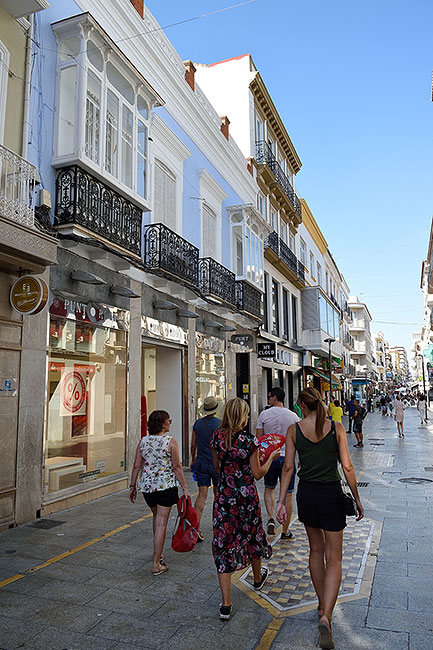
I did not stagger about in Ronda’s August heat alone, although the heat gnawed away more lustily at my geezerly energy stores than I had anticipated. Witness these fellow sightseers on Carrera Espinel, one of many pedestrian streets near the Puente Nuevo. Ronda-in-August wasn’t as thick with tourists as, say, Calle Preciados en Madrid or La Rambla in Barcelona, but it had more than its share.
I wonder if many Americans know about Ronda. I overheard occasional French and Italian in my two days in town, less frequent German and British English, but no other English spoken with an American accent like my own. Might have just been a fluke.
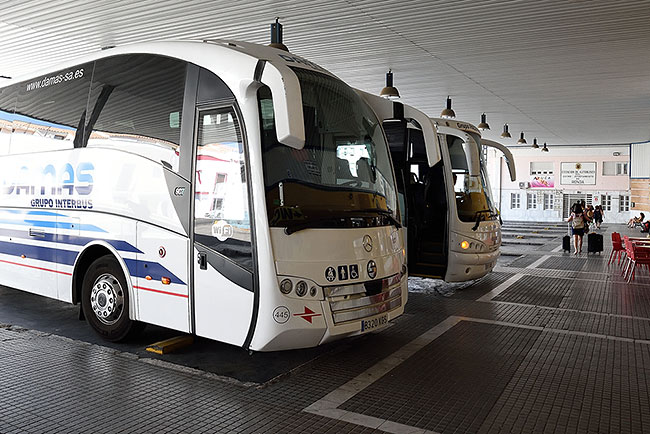
If I correctly read the schedules, Renfe offers two daily four hour non-stops from Madrid to Ronda, and two other trips with transfers. The train I wanted to ride was full. (No surprise, as I booked with two days notice.) I decided to ride a high-speed AVE to Sevilla instead, hop on a bus to Ronda, and ride the direct Ronda-to-Madrid train only on the return leg.
The bus at left above is the one I hopped upon, as photographed at the Ronda bus station. Alsa may be Spain’s biggest bus operator, but Alsa doesn’t go everywhere. Enter smaller companies like Damas, which offers a half-dozen daily buses on a new route linking Sevilla, Ronda, Chipiona and Málaga. I booked online for 12,71€, printed out a ticket, even remembered to bring it with me.
The ticket you want is from ‘Sevilla Prado S.S.’ (Prado de San Sebastian) to ‘Ronda,’ and not ‘Intermedio Ronda.’ Plug ‘Intermedio Ronda’ into an online map to see why I don’t want you to go there.
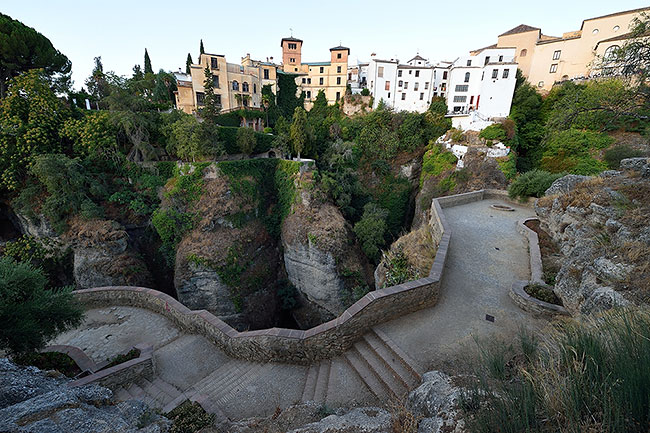
I heartily recommend a visit to the free Jardines de Cuenca, which cling to the cliffs on the northern side of the gorge and offer this view of buildings on the other side.
‘Cling’ may be a bit dramatic. Fire up Google Satellite Maps in 3D, mouse around the gorge and gardens, decide for yourself.
Photographers may be frustrated by the contrast of available light between buildings flanking the gorge and the gorge interior. Please visit the gardens anyway! You can’t always make your camera happy.
I added two un-captioned, full-size garden shots to the photo directory, here and here.
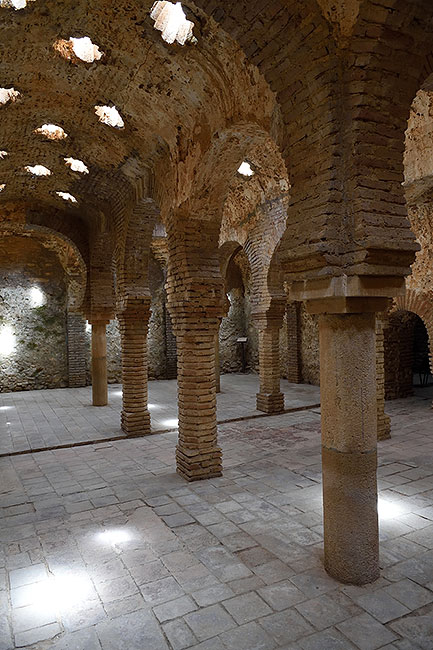
I read up on the Arab Baths only after returning to Madrid, now wish I’d devoted more time to exploring the interior. I’ll punt to a tourist web site, let them tell you what you’re looking at.
How deliciously cool I felt while exploring the baths, despite the 35°+ temps outside! I could have hung out, watched an English language video presentation, instead masochistically kicked myself outdoors.
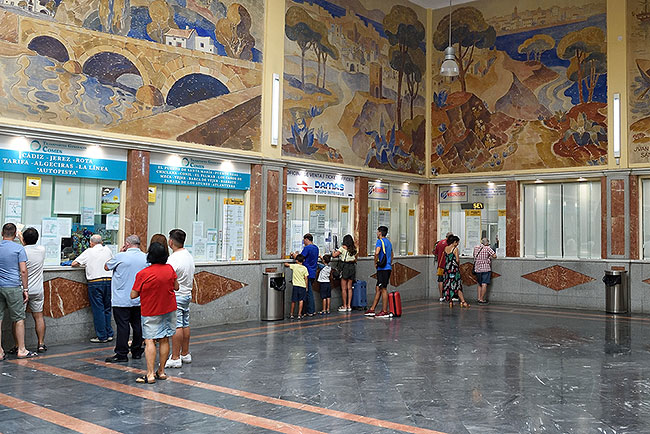
I wrote before that I hopped on a bus from Sevilla to Ronda. Technically correct, but the ‘hop’ first required a half-hour hike from Sevilla’s Santa Justa rail stop to the Prado S.S. bus station. A stroll on the un-touristy Calle Juan Antonio Cavestany got me there, thanks to the GPS signal on the one smartphone app I regard as indispensable, aside from an internet browser: a static map. I use RMaps, but maps.me and competitors may function as well or better.
The line at right is for Damas tickets. I’d already purchased mine online and printed it out at home, thus had no chores to do here.
LCD panels clearly showed ‘Llegadas’ and ‘Salidas,’ and directed travelers to clearly marked bus bays. That said, I stand by my impression that Spain bus companies and depots cater mostly to the native born. (I spotted no English option on the Damas web site, for instance.) Monolingual English tourists can expect more hand holding when riding the rails.
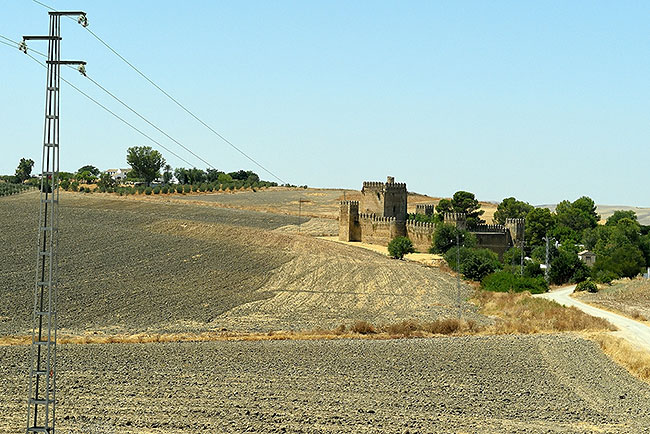
The terrain between Sevilla and Ronda — or, for that matter, between Madrid and Sevilla, too — often reminded me of Central California. I could have bagged this shot on Panoche Road west of the 5* in the Golden State, ‘cept for that tan structure with the crenelated roof, right of photo center.
(* Writing ‘west of the 5’ instead of ‘west of Route 5’ marks me as a native Californian. Sounds natural to me, makes others cringe.)
We don’t get many castles in California. In Spain, in contrast, I expect to occasionally spot a lonely old castle in the middle of nowhere, like this guy.
Four more full-size, snapped-from-the-train-or-bus shots: uno, dos, tres (another castle!), cuatro.
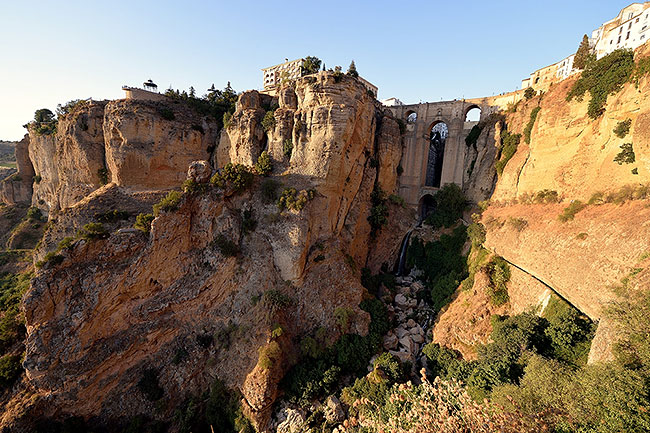
Fond as I may be of jokes about my age, I strive to maintain my geezerly bod in good form, and can keep up with young ‘uns in many activities. (At least if those activities don’t require a youthful prostate, rarely tested in sporting events.) Not in Ronda in August. I was plenty tuckered out by the time I descended into the gorge for some golden hour photography, surrounded by bright-eyed and bushy-tailed smartphone selfie snappers, and felt woozy as I clambered back up to the plaza. Straight to the Calle Armiñán main drag marched I, to buy and guzzle bottled mineral water. I hadn’t packed any. Dumb.
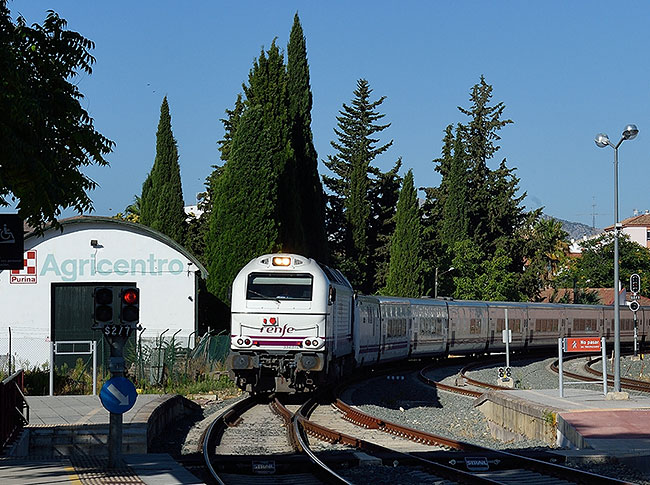
My Ronda-to-Madrid 09367 Altaria arrives at Estación Tren Ronda on August 17. Said station is a quarter hour stroll from Puente Nuevo, and poses no disagreeable surprises to tourists. I would have booked this ride both coming and going if my desired southbound train hadn’t been full, and if I hadn’t wanted to sample the Sevilla-to-Ronda bus route.
Four leisurely hours, and plenty of agreeable scenery, although not of the jaw-dropping caliber encountered in the Alps aboard the Bernina Express. Can’t have everything.
* * * * *
Interested in eyeballing high-res versions of the shots above? You can, along with some extras, in a directory of their own:
